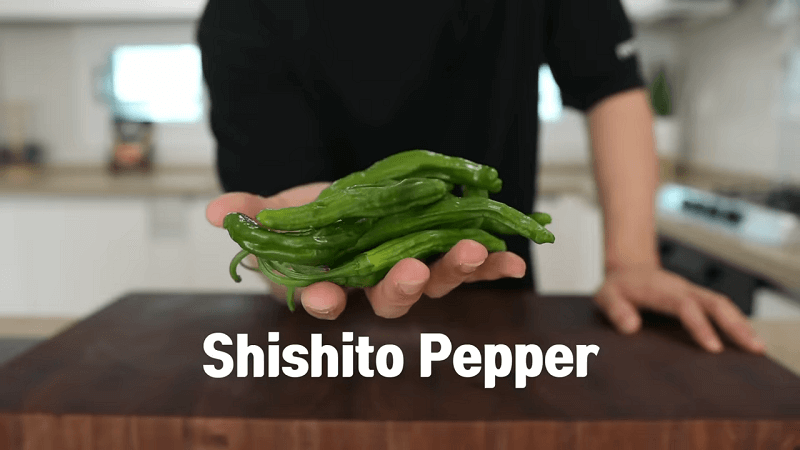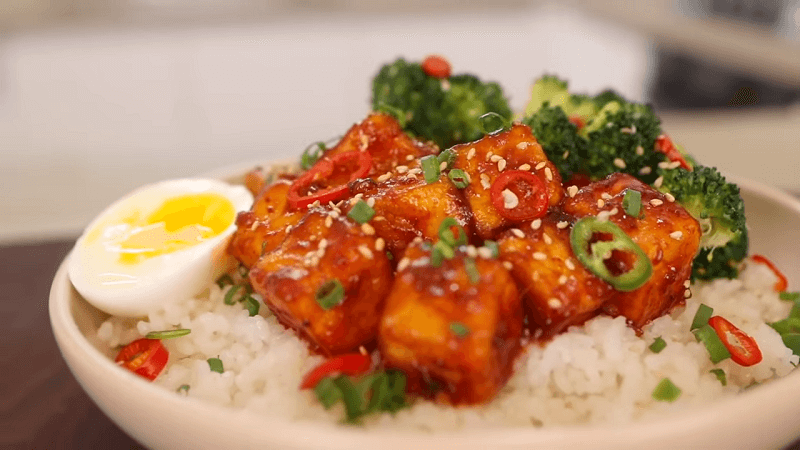Key Points
- I’ve crafted this Gochujang Korean Tofu Recipe over years in my kitchen, drawing from classic Korean flavors while tweaking for balance—it’s spicy, savory, and a bit sweet without overwhelming heat.
- Research suggests gochujang, the star paste, brings probiotic benefits and a metabolism boost, while tofu adds plant-based protein and heart-friendly nutrients, making this dish a solid choice for everyday meals.
- It seems likely that variations like adding broccoli or peanuts can suit different tastes, but evidence leans toward keeping it simple for authenticity, especially if you’re new to Korean cooking.
Why I Love Sharing This
Friends, this recipe started as my go-to for quick dinners. I first tried it after a trip to Seoul. Now, it’s a staple when I host casual hangouts.
Gochujang Korean Tofu Recipe
Quick Prep Overview
Press tofu to crisp it up. Mix sauce for that bold kick. Fry or bake—your call.
Basic Steps at a Glance
Dry and coat tofu. Cook until golden. Simmer in sauce and serve hot.
Hey friends, let me tell you about my Gochujang Korean Tofu Recipe. I’ve been tweaking it for ages. It packs that spicy punch with a savory edge.
I remember the first time I made it. I was in my tiny apartment kitchen. I had extra tofu and a jar of gochujang begging to be used.
Gochujang has deep roots in Korean food. It dates back to the 16th century when chilies hit Korea via trade routes. Fermented over time in earthen pots, it builds complex flavors. Tofu, or dubu, shows up in Korean dishes like jorim for braising.
This combo feels right at home. It’s vegan by nature. Plus, it’s quick for busy nights.
Now, why do I rave about it? The heat from gochujang wakes up your taste buds. Tofu soaks it all in. It’s nutritious too—gochujang aids digestion with enzymes, and tofu brings protein without the heaviness.
I’ve served it at barbecues. Folks always ask for seconds. It’s flexible for spice levels.
Let’s talk setup. You’ll need a good pan or oven. Pressing tofu is key for texture. Don’t skip that step.
I source gochujang from Asian markets. Look for fermented versions. They taste richer.
Tofu wise, extra-firm holds up best. It crisps without falling apart. I’ve tried softer ones—they turn mushy.
Sauce is where magic happens. Balance sweet, spicy, and umami. I’ve experimented a lot here.
Friends, this isn’t just food. It’s a story on a plate. Korean heritage meets my twists.
Prep time runs about 15 minutes. Cooking adds 20 more. Serves two to four easily.
Calories hover around 250 per serving. Protein hits 15 grams. It’s light yet filling.
I pair it with rice often. Steamed veggies on the side. Keeps things balanced.
One tip from experience: Taste as you go. Adjust heat early. Saves regrets later.
I’ve burned sauce before. Low heat prevents that. Stir constantly.
Now, onto ingredients. I’ll list them with prep notes. Keeps it simple.

Ingredients
Here’s what you’ll need. I’ve scaled for four servings. Adjust as you like.
Tofu (1 block, extra-firm, about 14-16 oz): Press between towels with weight for 20 minutes to remove water; cut into 1-inch cubes for even cooking.
Gochujang (3 tablespoons): Scoop from jar; it’s thick, so mix with warm water if clumpy for smooth blending.
Soy sauce (2 tablespoons, low-sodium preferred): Measure directly; use tamari for gluten-free option, no prep needed beyond opening.
Sesame oil (1 tablespoon): Drizzle from bottle; toasted version adds nutty depth, heat gently to avoid burning.
Brown sugar (1 tablespoon): Dissolve in sauce; sub maple syrup for vegan twist, stir until melted.
Garlic (4 cloves): Mince finely; peel first, then chop or use press for quick release of flavors.
Ginger (1-inch knob): Grate fresh; peel skin off with spoon edge before grating to infuse zing.
Rice vinegar (1 tablespoon): Pour straight; adds tang, sub mirin for sweeter note if handy.
Cornstarch (1 tablespoon for coating, 1 teaspoon for sauce): Mix with water for slurry; ensures crisp tofu and thick sauce.
Vegetable oil (2 tablespoons): Heat in pan; neutral flavor works best, pour carefully to coat bottom.
Green onions (2 stalks): Slice thinly; separate whites for cooking, greens for garnish fresh at end.
Sesame seeds (1 teaspoon): Toast lightly in dry pan; adds crunch, do this first to avoid forgetting.
Water (1/4 cup): Use for thinning sauce; room temp is fine, add gradually.
Optional add-ins like broccoli (2 cups florets): Steam briefly; cut into bite-size for quick cooking alongside tofu.
I keep these on hand. They last weeks. Makes whipping this up easy.

Step-by-Step Instructions
Let’s dive in. I’ll walk you through it. Like we’re cooking together.
First, prep your tofu. Pat it dry after pressing. Coat cubes in cornstarch mixed with salt.
Heat oil in a skillet over medium. Add tofu carefully. Fry until golden on all sides—about 8 minutes.
Flip halfway. Don’t crowd the pan. Do batches if needed.
Remove tofu. Set aside on a plate. Keep the pan hot.
Now, the sauce. Whisk gochujang, soy, sugar, garlic, ginger, vinegar, and water in a bowl.
Pour into the pan. Bring to a simmer. Stir until it thickens—around 3 minutes.
Add cornstarch slurry if needed. It binds everything. Taste for balance.
Toss tofu back in. Coat evenly. Let it bubble for 2 minutes more.
Garnish with onions and seeds. Serve right away. Heat fades fast.
If baking, preheat oven to 400°F. Toss coated tofu on a lined sheet. Bake 25 minutes, flipping once.
Sauce separately then mix. Crisps without oil splatter. I do this for bigger crowds.
Air fryer works too. 375°F for 15 minutes. Shake midway. Same sauce toss.
I’ve tried all methods. Frying gives best crunch. Baking is hands-off.
Add veggies mid-way. Broccoli chars nicely. Mushrooms soak up sauce.
Don’t overcook tofu. It gets chewy. Aim for firm outside, soft in.
Sauce clings better if tofu’s hot. Reheat if prepped ahead.
That’s the core. Simple, right? Now, let’s expand.

Why Crispy Texture Matters
Crispy tofu changes everything. It holds sauce without sogginess. Pressing is non-negotiable.
Cornstarch coating seals it. I’ve used potato starch—crisper but pricier. Stick with what’s available.
In Korean tradition, dubu buchim fries plain. My version amps it with gochujang for modern flair.
Flavor Deep Dive
Gochujang ferments with chilies, rice, soybeans. It adds umami depth. Not just heat.
Combined with garlic and ginger, it’s aromatic. Sesame oil finishes with nuttiness. Sugar tempers spice.
I’ve dialed back gochujang for milder batches. Friends appreciate options.
Health angle: Capsaicin in gochujang boosts metabolism. Probiotics from fermentation aid gut health.
Tofu packs isoflavones for heart support. Iron and calcium too. Feels good eating it.

Serving Ideas
Plate over jasmine rice. It absorbs extra sauce. Add kimchi for tang.
Veggies like cucumber salad refresh. Bell peppers stir-fried in. Broccoli steamed aside.
For bowls, layer rice, tofu, avo slices. Drizzle more sauce. Sesame seeds on top.
Wine? Light beer cuts spice. Or iced tea. Keeps it casual.
At hangouts, I serve family-style. Everyone digs in. Sparks conversations.
Storage and Reheating
Leftovers last 3 days in fridge. Airtight container. Sauce separates—stir back.
Reheat in microwave. 1 minute bursts. Or skillet with splash of water.
Freezes okay. Thaw overnight. Texture softens a bit.
I meal-prep batches. Sauce separate till eating. Stays crispier.

Variations to Try
Switch it up. Bake with breadcrumbs for extra crunch. Like one version I saw.
Add peanuts for sticky twist. Herbs like cilantro freshen. Inspired by peanut sauces.
Less spicy: Half gochujang, add ketchup for sweet. Kids love it.
Veggie-loaded: Mushrooms, onions in sauce. Turns into stir-fry.
Rice bowl style: Top with egg if not vegan. Or avocado for creaminess.
Sesame-heavy: More oil and seeds. Braise longer for dubu jorim vibe.
I’ve done air-fried with flakes. Extra heat. Or with mirin for gloss.
Table of Variations:
| Variation | Key Change | Why Try It |
| Baked Crispy | Breadcrumbs, oven 400°F | Less oil, hands-free |
| Peanut Sticky | Add peanut butter | Nutty depth, texture |
| Veggie Boost | Broccoli, mushrooms | More nutrition, bulk |
| Mild Version | Less gochujang, more sugar | Kid-friendly, gentle |
| Bowl Style | Rice base, toppings | Complete meal |
These keep it fresh. I rotate based on mood.

Common Mistakes I Avoid
Overcrowd pan—steams instead of crisps. Give space.
High heat burns sauce. Medium-low after adding. Stir often.
Wet tofu ruins crisp. Press thoroughly. I’ve learned the hard way.
Unbalanced sauce tastes off. Taste midway. Adjust soy or sugar.
Using soft tofu crumbles. Extra-firm only. Holds shape.

Nutrition Breakdown
Per serving: 250-300 calories. Depends on oil.
Protein: 15-20g from tofu. Carbs: 20g mostly sauce, rice extra.
Fats: 10g, healthy from sesame. Fiber low—add veggies.
Vitamins: Garlic brings antioxidants. Gochujang has capsicum for immune boost.
Low cholesterol. Plant-based win. I track for balance.
Table of Nutrients:
| Nutrient | Amount per Serving | Source |
| Protein | 18g | Tofu |
| Calories | 280 | Overall |
| Fiber | 2g | Veggies optional |
| Iron | 15% DV | Tofu, gochujang |
| Calcium | 20% DV | Tofu |
Fills you without weighing down. Perfect post-workout.

My Personal Touches
I add fresh chilies sometimes. For that kick. Reminds me of street food.
Experimented with corn syrup once. Glossy sauce. But sugar works fine.
At parties, I demo the toss. Friends join in. Makes it fun.
This Gochujang Korean Tofu Recipe evolves. Yours can too. Share your twists.

Frequently Asked Questions
What is gochujang exactly?
It’s a fermented Korean chili paste with soybeans and rice. Spicy, sweet, umami-packed. Find it in Asian aisles or online.
Is this recipe vegan?
Yes, all plant-based. Use tamari for gluten-free. No animal products here.
How do I make it less spicy?
Cut gochujang to 1 tablespoon. Add extra sugar or ketchup. Tastes milder without losing flavor.
Can I air-fry the tofu?
Absolutely. 400°F for 15-18 minutes. Shake basket. Toss in sauce after.
How long does it store?
Fridge for 3-4 days. Reheat gently. Freezes up to a month, but texture softens.
Substitutes for gochujang?
Sriracha with miso mimics it. But authentic is best. No perfect swap.
Is it gluten-free?
Check gochujang label—some have wheat. Use gluten-free soy. Then yes.
Can I add meat?
Sure, chicken or pork instead of tofu. Fry similarly. Adjust cook time.
Why press tofu?
Removes water for crispiness. Skip it, gets soggy. Worth the effort.
Pairings beyond rice?
Noodles, quinoa, or salads. Kimchi adds probiotics. Veggies balance heat
Gochujang Korean Tofu Recipe
Ingredients
- 150g firm tofu
- 1 tbsp gochujang (Korean red chili paste)
- 1 tsp soy sauce
- 1 tsp sesame oil
- 1/2 tsp sugar or honey
- 1 clove garlic, minced
- 1 tsp rice vinegar (optional)
- 1 tbsp water
- 1 tsp vegetable oil (for frying)
- Chopped green onions & sesame seeds for garnish
- Steamed rice or veggies (optional, for serving)
Notes
Cooking Steps:
- Prepare tofu: Pat tofu dry and cut into bite-sized cubes.
- Make sauce: In a small bowl, mix gochujang, soy sauce, sesame oil, sugar, garlic, rice vinegar, and water.
- Cook tofu: Heat vegetable oil in a pan over medium heat. Add tofu cubes and pan-fry until golden and crispy on all sides (about 6–7 minutes).
- Add sauce: Lower heat and pour the sauce over tofu. Stir to coat evenly. Let it simmer for 2–3 minutes until slightly thickened.
- Serve: Garnish with green onions and sesame seeds. Serve hot with rice or steamed vegetables
Hello! I am a seasoned culinary veteran whose passion for cooking began in my family kitchen and later I explored global cuisines. Now as a owner of the "OhMyRecipe" blog, I share my expertise by blending classic techniques with innovative twists. I advocates for culinary education and community engagement, making cooking accessible and enjoyable for all. Join me on a flavor-filled journey of delicious dishes and culinary inspiration.
- Jessica Hhttps://ohmyrecipe.com/author/abrecipe/
- Jessica Hhttps://ohmyrecipe.com/author/abrecipe/
- Jessica Hhttps://ohmyrecipe.com/author/abrecipe/
- Jessica Hhttps://ohmyrecipe.com/author/abrecipe/



